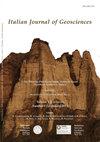Site-Specific PSHA: Combined Effects of Single-Station-Sigma, Host-to-Target Adjustments and Nonlinear Behavior. A case study at Euroseistest
IF 1
4区 地球科学
Q4 GEOSCIENCES, MULTIDISCIPLINARY
引用次数: 1
Abstract
This study takes advantage of the available information for an example, well-known, site in Greece (TST site at Euroseistest) to illustrate the epistemic variability in probabilistic seismic hazard assessment (PSHA) estimates. The purpose is not to perform an exhaustive site-specific PSHA at this particular site, but to investigate the sensitivity of the results to the approach used for including site effects, from basic ones to more demanding and realistic ones, in order to better appreciate the “benefits” versus the required costs and efforts of each approach. The TST site, located at the center of the Mygdonian basin in North-Eastern Greece is characterised by soft shallow soils over thick, medium stiffness deposits with a complex underground geometry, resting on very hard bedrock. Three different levels are considered for the incorporation of site response, from level 0 (generic or partially generic) to site-specific ones, with linear (level 1) or non-linear (level 2) site response analysis. The basic methods rely on one or several site proxies (V S30 , V SZ and f 0 ), whereas the most complex ones couple site response assessment (instrumental or numerical, implying site-specific characterization or instrumentation) with various reference rock hazard adjustments (single-station sigma, host-to-target adjustments, depth correction). Results are compared in terms of Uniform Hazard Spectra for a 5000 years return period, a typical value for critical facilities. For each level, the epistemic uncertainties are described and their impacts on hazard estimates are quantified. The use of the V S30 proxy in ground-motion prediction equations (GMPEs) leads to a clear underestimation of the hazard for the linear case (i.e., short return periods), especially around the site fundamental period, because of resonance and basin effects. On the other hand, soil nonlinearity largely impacts the hazard estimates, and linear amplification approach leads to an overestimation of the hazard, with unrealistic high levels at very long return periods. Site-specific hazard estimates for thick, Euroseistest-like sites, with complex geometry and rheology, are thus shown to come up against several additional epistemic uncertainties implying a large approach-to-approach variability. This may lead to increased hazard estimates, counterbalancing the decrease due to the use of reduced, single-site aleatory uncertainty in reference rock hazard estimates. For the time being, it thus looks unrealistic to promise a systematic reduction in hazard estimates with site-specific studies, while it might also indicate that uncertainties in generic hazard estimates could presently be underestimated.站点特异性PSHA:单站西格玛,主机到目标调整和非线性行为的综合效应。以Euroseistest为例
本研究利用了希腊一个众所周知的站点(Euroseistest的TST站点)的可用信息来说明概率地震危害评估(PSHA)估计中的认知可变性。目的不是在这个特定的地点执行详尽的特定地点PSHA,而是调查结果对用于包括地点影响的方法的敏感性,从基本的到更苛刻的和现实的,以便更好地了解“利益”与所需的成本和努力。TST场地位于希腊东北部Mygdonian盆地的中心,其特点是软的浅层土壤覆盖着厚的、中等刚度的沉积物,具有复杂的地下几何结构,坐落在非常坚硬的基岩上。考虑了三个不同的水平来纳入现场反应,从0级(一般或部分一般)到现场特定的,线性(1级)或非线性(2级)的现场反应分析。基本方法依赖于一个或几个站点代理(vs30, vsz和f0),而最复杂的方法将站点响应评估(仪器或数值,意味着站点特定的表征或仪器)与各种参考岩石危险调整(单站sigma,主机到目标调整,深度校正)结合起来。根据5000年回归期的统一危害谱(关键设施的典型值)对结果进行了比较。对于每个级别,描述了认知不确定性,并对其对危害估计的影响进行了量化。由于共振和盆地效应,在地震动预测方程(GMPEs)中使用V S30代理导致对线性情况(即短返回周期)的危害的明显低估,特别是在场地基本周期附近。另一方面,土壤非线性在很大程度上影响了危害估计,线性放大法导致了对危害的高估,在很长的回归期出现了不切实际的高水平。因此,对于具有复杂几何形状和流变学的厚的、类似欧洲地震的地点,特定地点的危险估计会遇到一些额外的认知不确定性,这意味着方法之间的差异很大。这可能导致危险性估计值的增加,抵消了参考岩石危险性估计值中减少的单点不确定性所带来的减少。因此,目前看来,通过具体地点的研究来承诺有系统地减少危险估计是不现实的,而这也可能表明,目前可能低估了一般危险估计的不确定性。
本文章由计算机程序翻译,如有差异,请以英文原文为准。
求助全文
约1分钟内获得全文
求助全文
来源期刊

Italian Journal of Geosciences
GEOSCIENCES, MULTIDISCIPLINARY-
CiteScore
2.90
自引率
11.10%
发文量
25
审稿时长
>12 weeks
期刊介绍:
The Italian Journal of Geosciences (born from the merging of the Bollettino della Società Geologica Italiana and the Bollettino del Servizio Geologico d''Italia) provides an international outlet for the publication of high-quality original research contributions in the broad field of the geosciences.
It publishes research papers, special short papers, review papers, discussion-and-replies for their rapid distribution to the international geosciences community.
The journal is firstly intended to call attention to the Italian territory and the adjacent areas for the exceptional role they play in the understanding of geological processes, in the development of modern geology and the Earth sciences in general.
The main focus of the journal is on the geology of Italy and the surrounding sedimentary basins and landmasses, and on their relationships with the Mediterranean geology and geodynamics. Nevertheless, manuscripts on process-oriented and regional studies concerning any other area of the World are also considered for publication.
Papers on structural geology, stratigraphy, sedimentology, basin analysis, paleontology, ecosystems, paleoceanography, paleoclimatology, planetary sciences, geomorphology, volcanology, mineralogy, geochemistry, petrology, geophysics, geodynamics, hydrogeology, geohazards, marine and engineering geology, modelling of geological process, history of geology, the conservation of the geological heritage, and all related applied sciences are welcome.
 求助内容:
求助内容: 应助结果提醒方式:
应助结果提醒方式:


